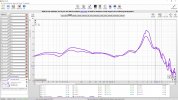This is a review, listening tests and measurements of the Dan Clark Expanse open-back planar magnetic headphone. It was loaned to me by the company and costs US $3999.
View attachment 230421
The design takes that of
Stealth headphone to another level with nicely done grill on the outside. It is very comfortable to wear, nicely molding to my head. You have a choice of cable connectors (I received the balanced XLR one). The cable itself is quite thick and sturdy but nicely drapes so no complaints there.
Dan Clark Expanse Measurements
Let's start with our frequency response and comparison to target:
View attachment 230424
Prior to measurement company had told me that it complied with the target but that they had dialed in a boost in that 100 too 300 Hz region as you see. We will evaluate this in the listening tests. For now, compliance to the target is the best of any open-back headphone that I have tested. It is only approximated by the company's own closed back Stealth headphone.
If you do want to create an EQ, here is the relative frequency response:
View attachment 230427
Note that measurements above 7 to 8 kHz are generally not accurate but I put a cursor there in case you want to play with that dip. Here is the group delay as areas to avoid (sharp spikes):
View attachment 230428
Vast majority of headphones show very messy group delay indicating mixing of phase due to reflections and or resonances in the headphone. Dan Clark headphones are an exception showing clear attention to keep these factors at bay.
Distortion at two playback levels is exceptionally low:
View attachment 230429
We get a SINAD of 86 dB which is limited by the measurement noise rather than true distortion of the headphone. For a transducer, it is basically distortion-less. There is a hump at 114 dBSPL but note that this headphone requires no boosting in low frequencies so that again, is excellent. Here is our absolute distortion at 94 dBSPL:
View attachment 230431
We have so much margin in the critical audible band of 2 to 5 kHz.
Impedance is a departure from typical planar headphone by showing some variation in low frequencies:
View attachment 230432
So likely some electronic components are in the path to provide the bass response we saw in the frequency response graph. Not an issue though as the variation is relatively small.
Sensitivity is very low so you better have good headphone amplification:
View attachment 230433
On my RME ADI-2 Pro, average listening level was about -6 dB. I could get more volume but even at max volume, I could not get the headphone to distort.
Edit: here is the impulse response:
View attachment 230797
Dan Clark Expanse Listening Tests
The small deviation in bass made subjective testing critical to assess whether that is or is not a good idea. I developed a correction for the filter (initially at -3 dB but later changed to -2 dB):
View attachment 230446
Listening with stock tuning, I enjoyed warmth that it added to my reference female vocals. Defeating it using EQ caused the vocals to stand out more, with slightly more spatial qualities. But the tonality comparatively could be said to be a bit bright. I preferred it without EQ. Moving to other clips, I occasionally would hear a bit of tubbiness which was made better with EQ. This was in cases where the tubbiness was already in the music and the boost in the response of the headphone exaggerated it a bit. Overall, I would say 70% of time of I preferred no EQ. For the others, if I didn't have EQ, it would still be delightful to listen to headphone. We are talking small differences here.
That bit aside, the superbly clean sound with very good spatial qualities and tonality that was right on the money, made the experience super enjoyable. On tonality the sound was familiar as in the sense of listening to a reference studio monitor but with none of the room modes. Low level detail was stunning at times in the way they would stand out with superb clarity.
Conclusions
What more could you ask for when a company delivers a headphone that both objectively and subjectively delivers on tonality, spatiality (instrument separation) and vanishingly low distortion? I know, you want it cheaper.

But this is the price right now for this unique offering in open back planar magnetic headphones. It is times like this that makes my "job" a delight!
It is my pleasure to recommend Dan Clark Expanse headphone. Delivering on best of audio science matters and matters a lot. Company's commitment to this is admirable.
----------
As always, questions, comments, recommendations, etc. are welcome.
Any
donations are much appreciated using
: https://www.audiosciencereview.com/forum/index.php?threads/how-to-support-audio-science-review.8150/


